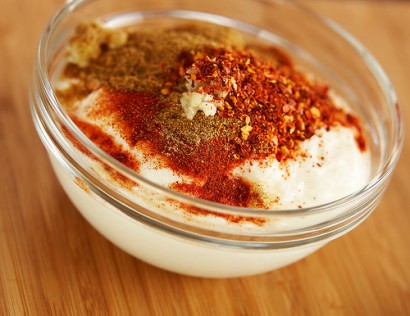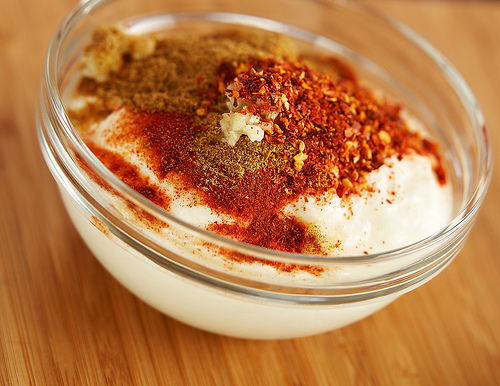
The spices to turn your Thanksgiving turkey into a Tandoori Thanksgiving turkey. (Photo: Flickr/foodthinkers)
In its founding myth, the Thanksgiving meal is a mix of immigrant and indigenous ingredients and traditions. It has English colonists and Native Americans celebrating the harvest with turkey and sweet potatoes, pumpkin pies and cranberry sauce. The New York Times’ food critic Sam Sifton, author of Thanksgiving; How to Cook it Well argues that the Thanksgiving meal should not and cannot deviate from the standard. Anything else he deems trendy or likely to fail.
For some that may be true. But the reality is American Thanksgiving meals are as diverse as the people eating them. For every new group of immigrants that comes to America, a new Thanksgiving tradition is born that mixes old and new. My own west coast Asian-American family prefers to roast a wild Sockeye salmon for our holiday meal. None of us like turkey.
Food writer, Monica Bhide and her husband were born in India but have lived in the United States for two decades. Their two young sons were born here. For them, the holiday is less about turkey and more about family and “gratitude”
“Our table is a reflection of our lives,” says Bhide. “While I do prepare a stuffing and chutney the American way, my brussels sprouts are seasoned with curry leaves, red chilies and mustard seeds.”
By chutney, Bhide, the author of three cookbooks including Modern Spice: Inspired Indian Flavors for the Contemporary Kitchen means cranberry sauce. Instead of turkey, she prepares tandoori chicken, her family’s favorite. Coated in spices like chilli and turmeric and roasted in a tandoori oven, the chicken is served with a cooling yogurt-sauce and has a distinctive bright red color. Bhide uses a conventional oven at home. She tried serving tandoori turkey once, but, as she says “at the end of the day, Thanksgiving is a meal about creating food that everyone loves, and my kids love the chicken!”
In lieu of pumpkin pie, Bhide makes a dish from her childhood: a cardamom and saffron seasoned rice pudding.
Ichi Vasquez is a graduate student from a large Puerto Rican and Dominican family. For a few years now they’ve celebrated the holiday at her aunt’s place in Washington Heights, Manhattan. The appetizers are snack foods from all over: salmon, crab cakes, dates, crackers and hummus. From then on it’s strictly Dominican: usually a garlicky roast pork dish called pernil served with moro—rice and beans—accompanied by salad and sweet plantains or arepas. Her aunt will usually cook some mashed sweet potatoes if asked.
After eating, says Vasquez, there’s usually dancing to salsa, merengue, and other Latin American music before getting to “the part of the night where my cousin, my uncle and my dad get into debates about who was the better musician—Elvis Presley or Michael Jackson.”
Wilneida Negron, at Ayuda Legal in New York, who is also Dominican and Puerto Rican, says her family makes a token attempt at North American tradition, having a small roast turkey or turkey breast on the table with stuffing alongside Caribbean-style stewed meats. “It’s more of an afterthought” says Negron.
In fact, Thanksgiving for Negron is synonymous in her mind with yucca mashed with garlic and olive oil. “There’s a time and place for mashed potatoes but holidays are for yucca” she says about the starchy tuber. “It’s a comfort food for our family.”
Her mother’s hybrid Thanksgiving specialty is a pumpkin dulce de leche seasoned with lots of Dominican nutmeg, a caramel topping and a flan base.
No, it isn’t all-American Apple Pie and stuffed poultry, but by adapting recipes and inventing new traditions immigrant cooks are recreating Thanksgiving’s founding story and upholding a much greater American tradition.
The following is Bhide’s recipe for Sizzling Tandoori Chicken from her Everything Indian Cookbook:
¾ cup Hung Yogurt
1 tablespoon Ginger-Garlic Paste
1 tablespoon Tandoori Spice Mix
¼ teaspoon carom seeds
Table salt, to taste
2 tablespoons fresh lemon juice
A few drops of red food coloring (optional)
2 tablespoons vegetable oil
8 skinless bone-in chicken thighs
Melted butter for basting
Chaat Spice Mix, for garnish
Serves 4–5
Prep Time: 15 minutes, plus at least 8 hours to marinate
Cook Time: 25–35 minutes
Serve this with the Punjabi Onion Salad, Simple Naan Bread, and Creamy Black Gram Dahl.
1. In a large bowl, combine the yogurt, Ginger-Garlic Paste, Tandoori Spice Mix, carom seeds, salt, lemon juice, red food coloring, and vegetable oil. Add the chicken and mix well to coat the chicken evenly. Cover and refrigerate for at least 8 hours, overnight.
2. Preheat oven to 400°.
3. Place the chicken in a single layer in a roasting pan. Discard any remaining marinade. Roast for about 20 to 30 minutes or until the chicken is cooked and the juices run clear. Baste as needed with the melted butter. Brown under the broiler for 6 to 7 minutes, turning once.
4. Garnish with a sprinkling of Chaat Spice Mix and serve hot.
Marinating Tip
When marinating chicken with bones, make small cuts in the chicken flesh. This allows the marinade to penetrate the chicken pieces. You can freeze the marinated chicken for use at a later date.
Fi2W is supported by the New York Community Trust and the John S. and James L. Knight Foundation with additional support from the Ralph E. Odgen Foundation and the Sirus Fund.




